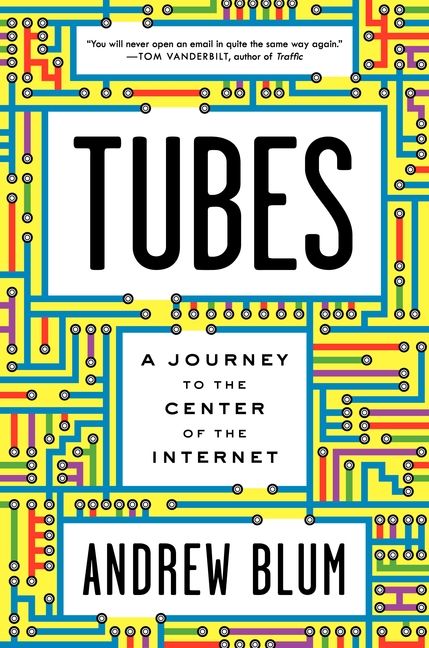In Tubes, published in 2012, Andrew Blum takes us on an engaging, utterly fascinating tour behind the scenes of our everyday lives and reveals the dark beating heart of the Internet itself. A remarkable journey through the brave new technological world we live in, Tubes is to the early twenty-first century what Soul of a New Machine—Tracy Kidder’s classic story of the creation of a new computer—was to the late twentieth.
Selected Praise for Tubes
“[This] quixotic and winning book is an attempt to comprehend the physical realities of the Internet, to describe how this seemingly intangible thing is actually constructed…Valuable, comic…[Blum has] a knack for bundling packets of data into memorable observations. What makes Tubes more than an unusual sort of travel book, is [Blum’s] sense of moral curiosity.”
Dwight Garner, The New York Times
“…Blum is a smart, imaginative, evocative writer who embraces the task of making his readers feel the wonder represented by these unprepossessing objects…So ingeniously beguiling is Blum’s way of conveying all this that, before you know it, you have acquired a sense of the basic structure of the Internet — from old-school exchanges to fiber-optic regeneration stations.”
“Fascinating and unique. . . . [A] captivating behind-the-scenes tour of how (and where) the Internet works. . . . [Blum] has a gift for breathing life into his subjects.”
Kirkus Reviews (starred review)
“Tubes is far more than a technical anatomy, revealing instead the broader implications of this seemingly ubiquitous parallel world that two billion of us inhabit, in one form or another, on any given day.”
“An engaging reminder that, cyber-Utopianism aside, the internet is as much a thing of flesh and steel as any industrial-age lumber mill or factory. It is also an excellent introduction to the nuts and bolts of how exactly it all works.”
From the Back Cover
When your Internet cable leaves your living room, where does it go? Almost everything about our day-to-day lives—and the broader scheme of human culture—can be found on the Internet. But what is it physically? And where is it really? Our mental map of the network is as blank as the map of the ocean that Columbus carried on his first Atlantic voyage. The Internet, its material nuts and bolts, is an unexplored territory. Until now.
In Tubes, journalist Andrew Blum goes inside the Internet's physical infrastructure and flips on the lights, revealing an utterly fresh look at the online world we think we know. It is a shockingly tactile realm of unmarked compounds, populated by a special caste of engineer who pieces together our networks by hand; where glass fibers pulse with light and creaky telegraph buildings, tortuously rewired, become communication hubs once again. From the room in Los Angeles where the Internet first flickered to life to the caverns beneath Manhattan where new fiber-optic cable is buried; from the coast of Portugal, where a ten-thousand-mile undersea cable just two thumbs wide connects Europe and Africa, to the wilds of the Pacific Northwest, where Google, Microsoft, and Facebook have built monumental data centers—Blum chronicles the dramatic story of the Internet's development, explains how it all works, and takes the first-ever in-depth look inside its hidden monuments.
This is a book about real places on the map: their sounds and smells, their storied pasts, their physical details, and the people who live there. For all the talk of the "placelessness" of our digital age, the Internet is as fixed in real, physical spaces as the railroad or telephone. You can map it and touch it, and you can visit it. Is the Internet in fact "a series of tubes" as Ted Stevens, the late senator from Alaska, once famously described it? How can we know the Internet's possibilities if we don't know its parts?
Like Tracy Kidder's classic The Soul of a New Machine or Tom Vanderbilt's recent bestseller Traffic, Tubes combines on-the-ground reporting and lucid explanation into an engaging, mind-bending narrative to help us understand the physical world that underlies our digital lives.
